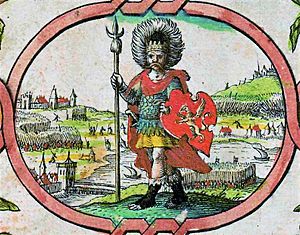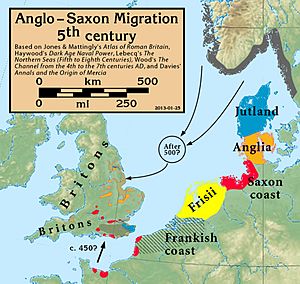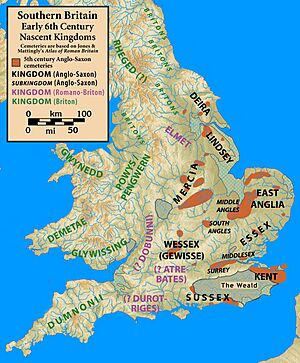Cerdic of Wessex facts for kids
Quick facts for kids Cerdic |
|
|---|---|

Imaginary depiction from John Speed's 1611 "Saxon Heptarchy"
|
|
| King of Wessex | |
| Reign | 519–534 |
| Predecessor | None (title established) |
| Successor | Cynric or possibly Creoda |
| Died | 534 |
| Issue | Cynric or possibly Creoda |
| House | Wessex |
Cerdic (pronounced CHUR-ditch) was an important leader in early English history. He is described as the founder and first king of Wessex, a powerful Anglo-Saxon kingdom. He ruled from 519 to 534 AD.
Many later kings of Wessex claimed to be related to Cerdic. However, historians still debate where he came from and if he truly existed. During his time, people might have known him as the king of the Gewissae, a local tribal group. The first ruler to call himself "King of the West Saxons" was Caedwalla in 686.
Contents
What's in a Name? Cerdic's Origins
Most experts believe the name Cerdic comes from an old British language, not a Germanic one. It might be a form of the British name Ceretic.
If his name is British, it could mean Cerdic was originally a native Briton. His family might have slowly adopted Anglo-Saxon customs over time. This idea is supported because some of his descendants, like Ceawlin and Caedwalla, also had names that might not be Germanic.
Cerdic's Early Life and Family
The Anglo-Saxon Chronicle, an old historical record, says Cerdic's family tree goes back to a god named Wōden. However, historians believe this family tree was created much later. It was likely copied from the family tree of other kings and doesn't show Cerdic's true ancestors.
When Cerdic and his son Cynric first appear in the Anglo-Saxon Chronicle around 495, they are called ealdormen. This was a lower rank at the time. It suggests they were not yet independent kings.
It wasn't until 519 that Cerdic and Cynric are said to have "begun to reign." This means they likely stopped being dependent on other rulers and became kings on their own.
Cerdic: King of Wessex
The Anglo-Saxon Chronicle states that Cerdic arrived in what is now Hampshire in 495. He came with his son Cynric in five ships. He is said to have fought and killed a British king named Natanleod in 508. He also fought at a place called Cerdicesleag in 519.
Natanleaga is thought to be Netley Marsh in Hampshire. Cerdicesleag is believed to be Charford, which means "Cerdic's Ford." The Chronicle also mentions that Cerdic conquered the Isle of Wight. He later gave it to his relatives, Stuf and Wihtgar. Cerdic is said to have died in 534, and his son Cynric became king after him.
The early history of Wessex in the Chronicle can be confusing. It sometimes has repeated events or information that seems to contradict itself. Some historians think Cerdic's actual reign might have been later, from 538 to 554.
Some scholars even suggest that Cerdic might be a legendary figure, not a real person. However, this is a less common view. The Anglo-Saxon Chronicle was written much later, in the late 800s. While it likely recorded old stories about Wessex's founding, it's hard to know how accurate they are after 400 years.
Being a descendant of Cerdic became very important for later kings of Wessex. He was claimed as an ancestor by Ecgberht, King of Wessex. Ecgberht was the ancestor of all later English and British monarchs.
See also
 In Spanish: Cerdic de Wessex para niños
In Spanish: Cerdic de Wessex para niños



